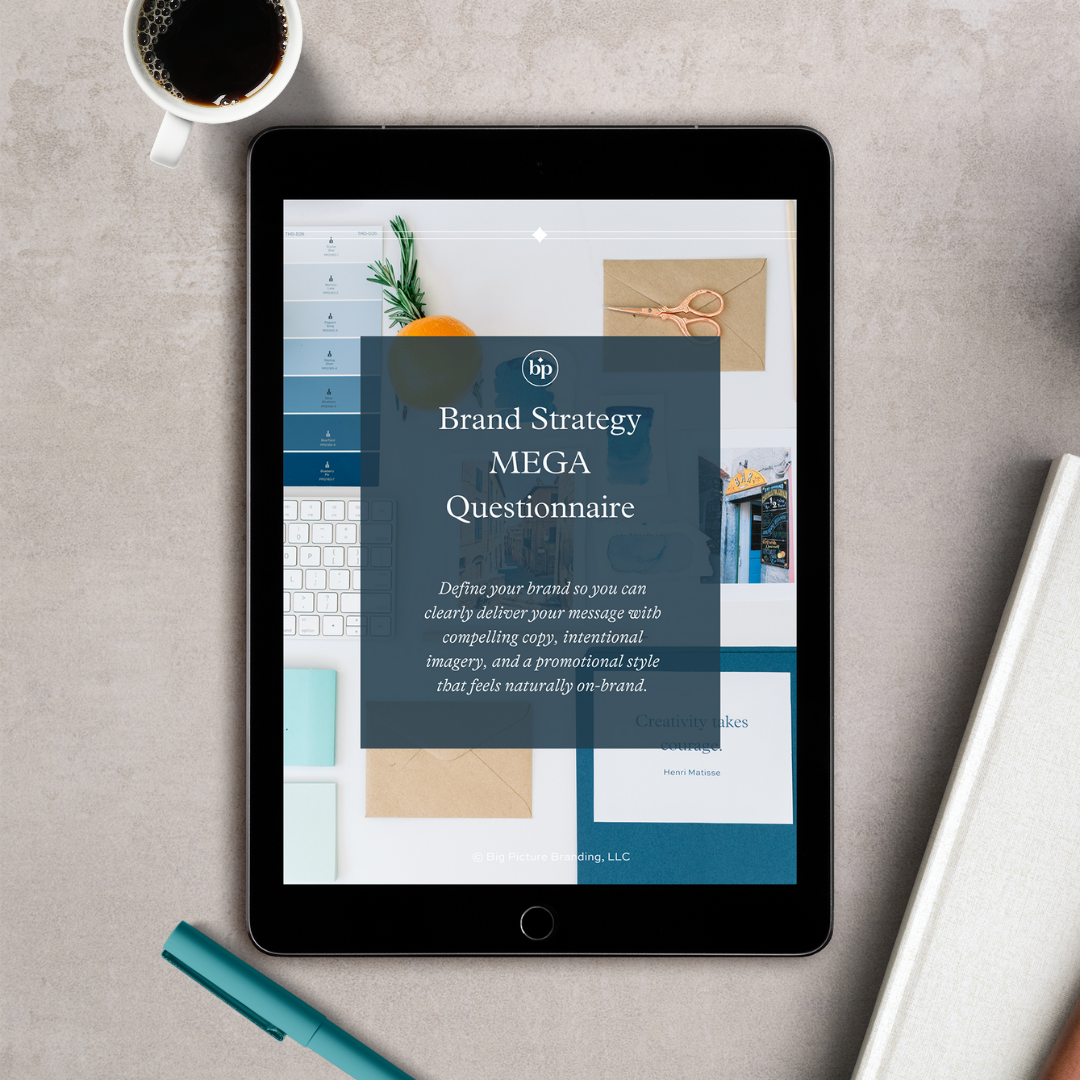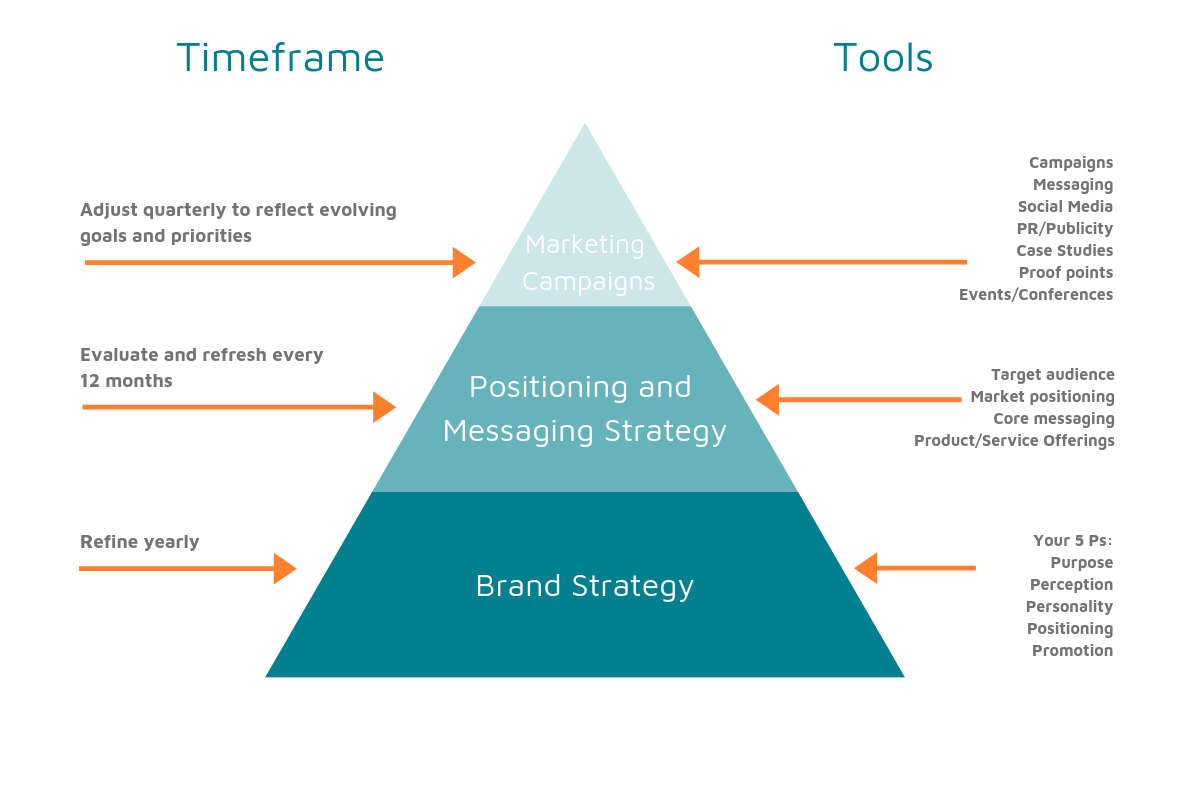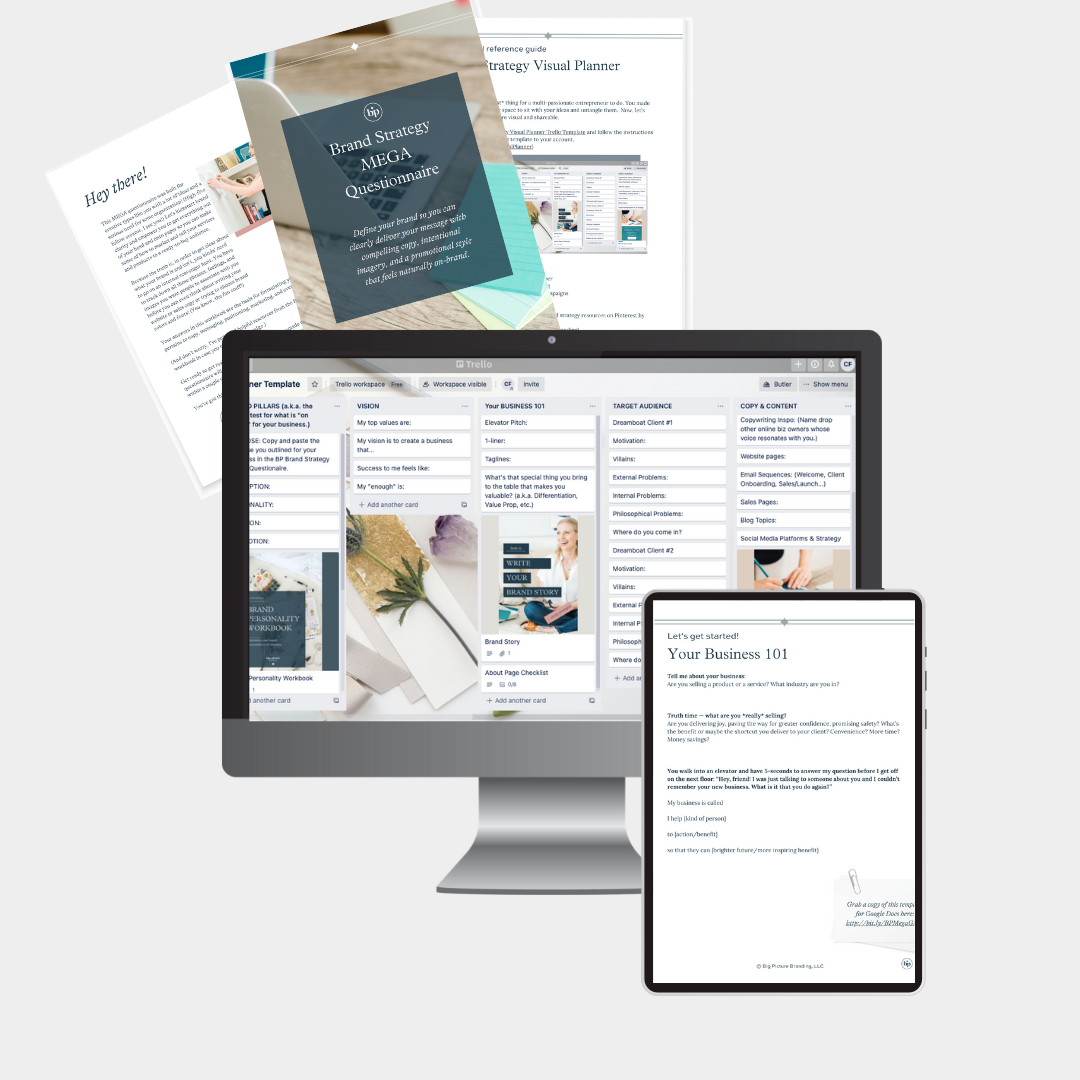Your business’ 5 Brand Pillars, Purpose, Perception, Personality, Position, and Promotion, are the foundation of your brand and the elements that inform every audience touchpoint and experience.
You have the power to craft your brand identity using the 5 Ps to make it the highest-performing asset your business owns.
Each pillar can be broken down into the questions they must answer. Address these questions and you have the framework for your organization’s Brand Pillars.
Before you continue…
I highly suggest running through this Brand Strategy MEGA Questionnaire (+ Trello Template). The questionnaire covers the A-Z of your brand with brand excavation prompts to help you find brand clarity, write website copy with ease, and begin to formulate your visual brand identity.

The 5 Brand Pillars
01: PURPOSE
-
Why does your brand exist with respect to the positive difference it makes in your audience’s lives?
-
What promises do you make to your audience?
-
Where did your purpose stem from? (E.g. Does your company history have anything to do with it?)
-
What motivates your purpose? (E.g. Why do you wake up every morning and continue down this path?)
Why Purpose is important:
Your purpose is your reason for being. The integrity of being a purpose-driven company comes from your commitment to stay true to your core. Every decision you make is in light of your purpose and your promise. Every experience your audience has with you should reflect your purpose in some way.
What’s more, your purpose can be a magnet for the types of people and personalities you’re looking to hire. By 2025, millennials will comprise 75% of the workforce.
Millennials want to be engaged with their work and feel that they are contributing to a bigger picture. They want transparency, and when comparing employers, they value purpose over profit.
On the consumer side, a study by Cone Communications found that that 9 out of 10 millennials would switch brands to support a particular cause and 87% would purchase a product with a social or environmental benefit.
Example: Patagonia
Patagonia’s mission is to “Build the best product, cause no unnecessary harm, use business to inspire and implement solutions to the environmental crisis.”
“Our values reflect those of a business started by a band of climbers and surfers, and the minimalist style they promoted. The approach we take towards product design demonstrates a bias for simplicity and utility.”
“We know that our business activity – from lighting stores to dyeing shirts – creates pollution as a by-product. So we work steadily to reduce those harms. We use recycled polyester in many of our clothes and only organic, rather than pesticide-intensive, cotton.”
“Staying true to our core values during thirty-plus years in business has helped us create a company we’re proud to run and work for. And our focus on making the best products possible has brought us success in the marketplace.”
02: PERCEPTION
-
What role do you play in the hearts and minds of your customers or audience?
-
What words do they use to describe you?
-
What do they perceive your value to be?
Why Perception is important:
Perception is a pillar that is owned by your audience. Your audience interprets your brand based on information gathered through messaging, design, online reviews, advertising, first-hand experiences with your brand and your word-of-mouth reputation.
Perception can be a difficult pillar to get right because we have a natural tendency to project how we think our audience perceives, us. The best way to avoid doing this is by asking your audience directly.
Your perception is how you make your audience think and feel when they interact with you. Your goal is to help shape and leverage that perception by creating first-hand moments that lead to positive associations once you’re gone.
Perception heavily influences purchase intent. Privy to that, Marketing, Design, Customer Service, and HR, in particular, can have a huge impact on your brand’s perception. When trying to cultivate or alter how you are perceived, it is imperative that these teams are informed and aligned on your brand and how they are your organization’s most important brand ambassadors.
What’s more, custom research and reviews shouldn’t stop with your external audience. Taking your internal temperature through employee surveys can be an invaluable way to understand if your external brand and internal culture are at odds with each other.
Misalignment between the two can mean disaster for employee-customer interactions, as well as your employee retention rates.
Examples: Most Stable Brand Perception Award: L.L. Bean
Functional. Stable. Tough. Guaranteed. Throughout its 100-year history L.L. Bean has been known for quality outdoor apparel with a no-nonsense customer service model that differentiates it from its competitors. Ripped seam in your boots? Send them back for a free repair and boot shine. Field coat not meeting your needs? Return it and a customer service rep will personally reach out to you to find out how the coat could have served you better, so the next design can be improved.
L.L. Bean doesn’t move quickly, to follow vapid consumer trends. Instead, it focuses on its bread and butter products and slowly building a repertoire of high-quality goods its consumers value enough to pay its higher price points.
Most Improved Brand Perception Award: Uber
Love them or hate them, Uber has spared no expense (half a billion) to improve their soiled brand perception. An ego-maniacal CEO (now, ex-CEO), corruption allegations, and widely reported stories about Uber’s toxic workplace environment made Uber a villainous brand with a brilliant product.
Through a slew of strategic PR and ad campaigns, Uber has begun rebranding itself by getting better at telling its stories — stories from the driver’s side and the passenger side — in order to highlight Uber as a public service product, once and for all.
Now, is Uber a purpose-driven business? No. But the example stands to show how important perception is and how costly is can be to rectify.
03: PERSONALITY
-
What is your brand’s point of view?
-
What’s your mood?
-
When you speak to your customers or audience, what tone of voice do you use?
-
What are some of the key words you use when speaking to your audience?
-
What is your workplace culture like?
-
What are some of the words your employees use to describe their workplace?
Why Personality is important:
Once you determine your brand’s personality, you can define your voice and tone — essentially, how you speak to your audience across multiple platforms. Your personality can differentiate you from your competitors and make you easily recognizable in a crowded marketplace. Customers become repeat customers when they know what to expect when engaging with you.
Internally, your brand’s personality signals to employees and applicants your workplace culture and how they might be expected to behave.
It can be valuable to play “this but not that” to clarify the nuances of your values.
Example: Mailchimp
“Our humor is dry. Our sense of humor is straight-faced, subtle, and a touch eccentric. We’re weird but not inappropriate, smart but not snobbish.”
If you’re struggling to define your personality traits, sign up to receive my 10-Minute Brand Personality Workbook to get a jumpstart.
04: POSITION
-
Who are you attempting to appeal to and why?
-
Who are you currently attracting? Is this different then who you’d like to attract?
-
What category is your brand competing in?
-
Where do you currently stand in the marketplace, in relation to your competitors?
-
Where would you like to stand in the marketplace, in relation to your competitors?
-
What is the most compelling (emotional/rational) benefit to your target customers that your brand can own relative to your competition?
-
What is the most compelling evidence that your brand delivers on its brand promise?
-
Future positioning goal: What’s your long-term vision for your company? What are you working toward?
-
Fill-in-the-blank: For [target customers], [your company/organization name] is the [market definition] that delivers [brand promise] because only [your company/organization name] is [proof].
Why Position is important:
Position is as much about growth as it is about determining your own limits. Your brand has to be realistic about what it offers your audience today while working toward future business evolutions, in tandem.
How do you plan for business evolution without confusing your customer? By having a brand strategy.
Here’s one way to look at how to evolve your brand positioning without sacrificing your core brand:

Example: Amazon (from 2001)
For World Wide Web users who enjoy books, Amazon.com is a retail bookseller that provides instant access to over 1.1 million books. Unlike traditional book retailers, Amazon.com provides a combination of extraordinary convenience, low prices, and comprehensive selection.
Amazon’s position in the online market as a place of extraordinary convenience, low prices, and comprehensive selection has remained the same for nearly 20 years. Sticking to these core values has allowed Amazon to expand the type of products it ships (not just books) and become the behemoth it is today, without confusing or alienating its customers.
05: PROMOTION
-
Where do your customers or audience expect to find you?
-
Where would your brand’s presence feel out of place?
-
What is your organization’s elevator pitch?
-
Who are your greatest brand ambassadors?
-
Who manages your brand and its standards?
-
When there is a client/customer problem, how does your brand handle the situation?
Why Promotion is important:
Before we dig in, let me clarify that sales promotion and brand promotion are two very different things. Short-term sales promos such as limited-time offers, discount codes, donation matching, and giveaways are about making a sale or transaction now. Brand promotion seeks to build loyalty by winning over the hearts and minds of your audience so that your product or service becomes the go-to solution or recommendation every time.
Brand promotion is about walking the talk.
Here are some things to remember when promoting your brand:
Consistency matters
Apply your brand standards to everything and keep it consistent: email and social media voice and tone, logo usage, writing and content style rules, customer service scripts, sales and marketing messaging.
When your audience checks out your website, and then clicks over to your Twitter account, they should feel like you’re still having the same conversation with them, the only thing that has changed is the medium.
One way to encourage brand consistency is for every employee to have access to a brand voice and style guide.
Know your elevator pitch
Everyone in your organization, from the front desk to the CEO should know how to describe your organization, how to talk about your value proposition and exemplify your values. And while every employee needs to be involved to varying degrees, employee buy-in has to start at the top. If your CxO rolls his or her eyes whenever your company’s purpose is discussed, that sends a very clear message that there is a breach of trust somewhere and it undermines the people whose jobs it is to contribute to, market, and sell your organization.
Internally, not only should employees be given your company’s elevator pitch and brand values during the onboarding process, your leadership team should make a concerted effort to talk about your values openly in inter-company communications and connect those values to the business decisions being made.
Externally, aligning your message with your business goals is the simplest and most effective way to tell your audience who you are and why they should care.
For example:
“As a copywriter and brand messaging strategist for creatives and entrepreneurs, Courtney Fanning helps you wrap your head around what you’re trying to build to create differentiated messaging that resonates with your dreamboat clients. As the founder of Big Picture Copywriting, Courtney provides 1:1 client services as well as marketing and copywriting resources and courses for DIY online businesses. Courtney has worked with New York Times bestselling authors, purpose-driven startups, multi-passionate multi-hyphenates, and ambitious dreamers alike to build a big-picture strategy that turns purpose into profit. Her clients have appeared in Forbes, SXSW, Apartment Therapy, Rising Tide Society & more.”
Be passionate
Toot your own horn! Company awards, employee accomplishments, client success stories — these aren’t just events to help your brand distinguish itself from your competitors, they’re a great way to highlight the hard work and esteemed caliber of your employees bring to the table. When employees feel valued, workplace satisfaction goes up, which can absolutely be felt by clients and customers.
Your employees are your strongest brand ambassadors. Making an effort to celebrate victories big and small can have a huge impact on your brand promotion efforts.
Have an S.O.S. plan
Even the most powerful brands in the world make mistakes. Having a plan (a customer service script or agreed upon social media message) in case of emergency allows you to inform your audience that:
-
You are aware of the problem
-
Steps are being taken to rectify the problem
-
You apologize for the problem
-
You will take the necessary steps to make sure it doesn’t happen again
-
Your audience is immensely valuable to you
-
You will do everything you can to regain their trust
Whether your website crashed, you ran out of a product, you have an unhappy customer or experience a PR snafu, always put your best face forward and be genuine.
Get started with the Brand Strategy MEGA Questionnaire

PIN TO SAVE FOR LATER

